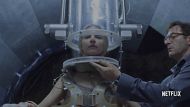There's a lot to look at on the set of the new Red Dog film. The striking red dirt and rocky landscape of Karratha Station in remote Western Australia. Director Kriv Stenders and his crew shooting between unseasonal downpours. There's even Bryan Brown, holding court at the catering tent.
But it's hard to take your eyes off "Blue". Just out of shot of the camera, trainer Zelie Bullen is preparing Phoenix, a three-year-old kelpie, for a scene in which Blue carries a piece of cloth. Walking past is another "Blue" and there are two more sitting under an awning. All up, there are six of them on set.
More Trailers Videos
Trailer: Red Dog: True Blue
The start of Red Dog's story when he's discovered on the road to Dampier, and his ultimate rise to Australian legend.
They say it takes a village to raise a child. Well, it takes a kennel to make a Red Dog film.
In the warm-hearted drama that was a hit five years ago, the charismatic Koko played a wandering kelpie who united a mining community in the 1970s. For the prequel, Red Dog: True Blue, the filmmakers searched the country for a younger dog and ended up at the same Victorian breeder who raised Koko. Their new star is a cousin.

"It was like finding an actor," Stenders says during a break in filming. "You have to audition them. And like humans, they've got to have that X factor. They've got to have that ability to look good on camera and concentrate and not get distracted. It took eight months but we finally found our guy."
For this prequel, which centres on the bond between a city kid named Mick and a scrappy kelpie named Blue in 1968, the filmmakers needed six identical dogs.
"We actually have three groups of dogs," Stenders says. "Primarily there's Phoenix. He's our close-up dog and he's the dog that does the majority of the work. He has a double that we keep on set all the time just in case Phoenix for some reason can't finish off a scene or he's got a hangover or is having a tantrum," he jokes.
"We also have a second set of dogs – second unit dogs – for wider shots and movement. Then we have a third set of dogs for long distance running shots."

The story traces the bond between Blue and 11-year-old Mick (Levi Miller from Pan), who is sent to his grandfather's cattle station following his father's death. At the same time it charts many of the changes taking place in Australia during the late 1960s.
Young Aboriginal stockman Taylor Pete (newcomer Calen Tassone) is on the way to becoming an activist over low wages and poor conditions. Helicopter pilot Stemple (Thomas Cocquerel) is back from the Vietnam War. Mick's tutor Betty (Hanna Mangan Lawrence) wants a career of her own and stockmen Little John and Big John (Syd Brisbane and Steve Le Marquand) might be more than just good friends. And in the Pilbara, agriculture is on the way out as mining takes over.

"This film is very historically and geographically located," producer Nelson Woss says. "It's pointing to the resonances of what was happening – to indigenous communities and to farming communities once mining came in. It's a film about two worlds: the old world ending and the new world beginning."
Like just about everyone else, Stenders was surprised by how successful Red Dog was five years ago. The drama became one of the country's most successful films at the domestic box office – it's still No.10 with earnings of $21.4 million. It also won best film at the 2012 Australian Academy of Cinema and Television Arts Awards.

"We were pretty overwhelmed by the response," Stenders says. "It was very much a justification of what we were trying to go for – making a film for everyone: for children, for adults, for grandparents. It seemed to do that trick of crossing every quadrant."
Stenders believes different elements of the film appealed to different age groups.

"Firstly, there was the nostalgia element: the idea that we were looking back at an Australia that doesn't exist any more," he says. "For a certain generation, that's still a very evocative, very iconic time in our lives. There's also a lovely sense of community in the film – in fact, in both films.
"I think audiences like that feeling that they're part of a family of characters. And the film dealt with very simple human emotions and life lessons – change, death, the inevitability of certain things happening, love, friendship – all told in a folklorish kind of way. When you can't create big spectacle and crash hundreds of cars, emotion is relatively cheap, though not necessarily easy to achieve.
"Oh, and Australians love dogs," he says. "We've just got a soft spot for them."
While Woss flagged a plan to make a trilogy of red, blue and yellow dog films, it took time for writer Daniel Taplitz to come up with a compelling idea for the next instalment. Not so easy when – spoiler alert if you haven't seen Red Dog – the kelpie died in the original film.
"We threw a few ideas around but there was never anything that really felt right," Stenders says. "It wasn't until late in 2013 that Dan pitched us this idea which was very different from the other sequel ideas we'd been thinking about. It was just very clever – a very simple idea, a very clever conceit – and I knew it was worth making."
That idea was an origin story framed by a contemporary tale centring on a harried father (Jason Isaacs from the Harry Potter movies) telling his sons about Red Dog.
"You get to see how Red Dog became Red Dog," Stenders says. "But it also stands alone as its own film: you won't have had to have seen Red Dog to enjoy this one."
The first film was based on a book by Louis de Bernières that drew on stories about the real life dog who has his own statue in Dampier. Stenders says the prequel is "pretty much fictional" except for Red Dog being called Blue and having a previous owner before the events of the first film.
If finding the right dog was a challenge, it was much easier finding a young actor to play Mick. Miller impressed with a self-taped video audition.
"There were a lot of great kids but Levi stood out a million miles in front of everyone," Stenders says. "Levi has an amazing screen presence – he's got these amazing blue eyes – and he felt completely authentic and credible as a kid from 1968."
The gently spoken Miller grew up in Queensland and, with two sisters who are involved in dancing and performance, has been acting "since just before first-grade".
"It was such a sweet, cute story," he says during a break in shooting. "I had to do it. I was excited to work with a dog. I've always wanted to work with an animal.
"There's my friend over there, Phoenix."
As a fan of the first film, Bryan Brown, who plays Mick's grandfather, was "really interested in what they'd do with the second one".
He was impressed by the subtleties of the script.
"It was a transitional time in Australia and it was quite nicely threaded into the story without it being about social issues or the issues of the day," he says. "On first read, I hadn't particularly noticed that. But the more I went back, the more I saw the subtlety of what they were trying to do."
Brown, 69, jokes about how much time has passed since his early starring roles in Newsfront (1978), Breaker Morant (1980) and A Town Like Alice (1981).
"I go to the door of my caravan and it says 'grandpa'," he says. "It's like 'oh f---!'."
Because they planned to film on a culturally significant site at Karratha station and feature a storyline about Aboriginal involvement in the pastoral industry, the filmmakers went to great lengths to collaborate with the local Ngarluma community.
"We did a lot of negotiation over the script," says Indigenous adviser Clinton Walker. "We had plenty of input into that, which was great. The guys in the film were very serious about involving Aboriginal people."
It might be a family film about a boy and a dog but Red Dog: True Blue bundles up all sorts of strands of a mythical Australia in the late 1960s.
"We're tapping into the collective subconscious that we have as a nation," Stenders says. "These are our myths; these are our stories."
Red Dog: True Blue opens on Boxing Day.















